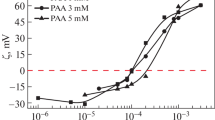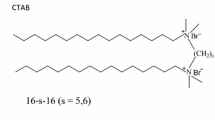Abstract
The solution properties of homogeneous hexaethylene and octaethylene glycol mono(n-dodecyl) ethers, C12E6 and C12E8, respectively, and octaethylene glycol mono(n-decyl) ether, C10E8, with poly(methacrylic acid) (PMA) were investigated by dye solubilization, surface tension, fluorescence, viscosity, and pH measurements. The data were discussed regarding non-cooperative and cooperative binding of surfactant to polymer. Whereas in the interaction with poly(acrylic acid) (PAA), the critical aggregation concentrations (cac or T 1) of these surfactants were lower than the respective critical micelle concentration (cmc), in that with the more hydrophobic PMA, T 1’s of C12E6 and C12E8 were higher than the respective cmc, but that of C10E8 was lower than its cmc. These may be ascribed to the hydrophobic microdomains (HMD) of the PMA coil in water, probably in its inside. It is considered that some surfactants are bound first to the HMD non-cooperatively and then they are abruptly bound cooperatively at T 1. This raises T 1 higher than cmc when the cmc is low, and the amount bound by the HMD is relatively large and vice versa. T 1 of C12E6 or C12E8 is the former case, and that of C10E8 is the latter. Thus, different from PAA, T 1 for PMA + nonionic surfactant system consists of the amount of non-cooperative binding and the cac of the cooperative binding in equilibrium. Therefore, this T 1 has a different meaning from that for PAA and should be called apparent T 1. As the binding to the HMD is dependent on PMA concentration and cac is not, which is like in the PAA system, separation of apparent T 1 from the HMD binding was achieved by extrapolating T 1’s to zero PMA concentration (denoted intrinsic T 1). This value for C12E8 was found to be lower than the respective cmc and also lower than the respective T 1 for PAA. With increase in surfactant concentration, the pH of PMA solution rose and demonstrated a peak. This pH rise and fall may be induced by loosening of the HMD coil due to binding increase and by rearrangement of PMA + surfactant complex in high surfactant concentrations region. By raising the initial pH, the HMD were loosened; consequently, T 1 rose a little, and at higher pH, no surfactant binding took place.








Similar content being viewed by others
References
Goddard ED, Ananthapadmanabhan KP (eds) (1993) Interactions of surfactants with polymers and proteins. CRC Press, Boca Raton, FL
Kwak JCT (ed) (1998) Polymer–surfactant systems. Marcel Dekker, New York
Saito S, Taniguchi T (1971) Kolloid Z 248:1039
Saito S (1979) Colloid Polym Sci 257:266
Saito S (1989) J Am Oil Chem Soc 66:987
Petrova T, Rashkov I, Baranovsky V, Borisov G (1991) Eur Polym J 27:189
Baranovsky V, Shenkov S, Rashkov I, Borisov G (1991) Eur Polym J 27:643
Baranovsky V, Petrova T, Rashkov I (1991) Eur Polym J 27:1045
Baranovsky V, Shenkov S, Rashkov I, Borisov G (1992) Eur Polym J 28:475
Baranovsky VY, Shenkov S (1994) Eur Polym J 30:601
Wasserman AM, Yasina LL, Aliev II, Doseva V, Baranovsky VY (2004) Colloid Polym Sci 282:402
Saito S (1987) Polymer–surfactant interactions. In: Schick MJ (ed) Nonionic surfactants physical chemistry. Marcel Dekker, New York, pp 881–926
Saito S, Anghel DF (1998) Interactions of polymers and nonionic surfactants. In: Kwak JCT (ed) Polymer–surfactant systems. Marcel Dekker, New York, pp 357–408
Anghel DF, Saito S (2004) Recent Res Devel Surface Colloids 1:301
Saito S (1990) Rev Roum Chim 35:821
Anghel DF, Winnik FM, Galaţanu N (1999) Colloids Surf A 149:339
Saito S (1977) Tenside 14:113
Galaţanu AN, Chronakis IS, Anghel DF, Khan A (2000) Langmuir 16:4922
Anghel DF, Saito S, Iovescu A, Băran A (1994) Colloids Surf A 90:89
Anghel DF, Saito S, Băran A, Iovescu A (1998) Langmuir 14:5342
Anghel DF, Saito S, Băran A, Iovescu A (2005) Rev Roum Chim 50:570
Vasilescu M, Anghel DF, Almgren M, Hansson P, Saito S (1997) Langmuir 13:6951
Raicu V, Băran A, Iovescu A, Anghel DF, Saito S (1997) Colloid Polym Sci 275:372
Raicu V, Băran A, Anghel DF, Saito S, Iovescu A, Rădoi C (1998) Progr Colloid Polym Sci 109:136
Băran A, Iovescu A, Raicu V, Anghel DF, Saito S, Anghel C (2003) Ann West Univ Timis Ser Chem 12:909
Băran A, Iovescu A, Raicu V, Anghel DF, Saito S (2003) Ann West Univ Timis Ser Chem 12:847
Saito S (1994) J Colloid Interface Sci 165:505
Kiefer J, Somasundaran P, Ananthapadmanabhan KP (1993) Langmuir 9:1187
Katsuura H, Kawamura H, Manabe M, Maeda H (2002) Colloid Polym Sci 280:30
Chu DY, Thomas JK (1986) J Am Chem Soc 108:6270
Baranovsky VY, Shenkov S, Borisov G (1993) Eur Polym J 29:1137
Thuresson K, Söderman O, Hansson P, Wang G (1996) J Phys Chem 100:4909
Zana R (1998) Polyelectrolyte–surfactant interactions: polymer hydrophobicity, surfactant aggregation number and microstructure of the systems. In: Kwak JCT (ed) Polymer–surfactant systems. Marcel Dekker, New York, pp 409–454
D’Errico G, Ciccarelli D, Ortona O, Paduano L, Sartorio R (2004) J Colloid Interface Sci 270:490
Goddard ED (1993) Polymer–surfactant interactions. In: Goddard ED, Ananthapadmanabhan KP (eds) Interactions of surfactants with polymers and proteins. CRC Press, Boca Raton, FL, pp 123–203
Maloney C, Huber K (1994) J Colloid Interface Sci 164:463
Radlinska E, Gulik T, Lafuma F, Langevin D, Urbach W, Williams CE, Ober R (1995) Phys Rev Lett 74:4237
Asnacios A, Klitzing R, Langevin D (2000) Colloids Surf A 167:189
Nishikido N, Takahara T, Kobayashi H, Tanaka M (1982) Bull Chem Soc Jpn 55:3085
Dai S, Tam KC (2005) Langmuir 21:7136
Dong DC, Winnik MA (1984) Can J Chem 62:2560
Kalyanasundaran K, Thomas JK (1977) J Am Chem Soc 99:2039
Lynch I, Sjöström J, Piculell L (2005) J Phys Chem B 109:4252
Wei YC, Hudson SM (1995) J Macromol Sci Rev Macromol Chem Phys C 35:15
Author information
Authors and Affiliations
Corresponding author
Rights and permissions
About this article
Cite this article
Anghel, D.F., Saito, S., Băran, A. et al. The aggregation of nonionic surfactants in the presence of poly(methacrylic acid). Colloid Polym Sci 285, 771–779 (2007). https://doi.org/10.1007/s00396-006-1617-1
Received:
Accepted:
Published:
Issue Date:
DOI: https://doi.org/10.1007/s00396-006-1617-1




